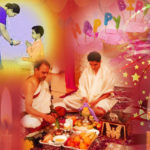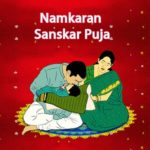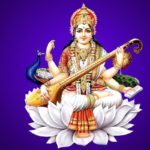
Gand Mool Nakshatra Shanti Puja
Introduction
The birth of a child in this material universe is a resultant action of the deeds which he has been doing over his past lives. Some are sinful and some are pious to the level of Karma. Unless the human being transcends the path of fruitive activities or Sakaam Karma, he has to take birth in this material universe again and again.
As stated in Bhagwad Gita (9.21)
“When they have thus enjoyed heavenly sense pleasure, they return to this mortal planet again. Thus, through the Vedic principles, they achieve only flickering happiness.”
This shows that one who is promoted to those higher planetary systems enjoys a longer duration of life and better facilities for sense enjoyment, yet one is not allowed to stay there forever. One is again sent back to this earthly planet upon finishing the resultant fruits of pious activities.
He who has not attained perfection of knowledge, as indicated in the Vedanta sutra (janmady asya yatah), or, in other words, he who fails to understand Krishna, the cause of all causes, becomes baffled in achieving the ultimate goal of life and is thus subjected to the routine of being promoted to the higher planets and then again coming down, as if situated on a Ferris wheel which sometimes goes up and sometimes comes down.
And hence, when he is born on this planet earth, he has some destiny of his own which is indicated by the planets and constellations at the time of his birth. These planetary arrangements verily decide the fate of the child.
Gand Mool Nakshatras
As per the treatises of Astrology or Jyotish shastras, there are 27 nakshatras or constellations which are the 27 equal divisions of the lunar path. The path treaded by the moon in the year is equally divided into 27 divisions and each sector comprises of a Nakshatra which is further divided into four charanasor the four steps.
Out of 27, the ones ruled by the planets Mercury and Ketu are the ones which are termed as Gand Mool Nakshatras.
The nakshatras which come under Gand mool are:
Ashwani
Ashlesha
Magha
Revati
Jyestha
Moola
These six are termed as Gand mool nakshatras and their presence is not so auspicious for the child. Mool, Jyesth and Ashlesha are more inauspicious. As per the authority of ‘Jyotish Tatwa‘, the starting 5 hours of Ashwini, Magha and Moola and ending 5 hours of Ashlesha, Jyeshth and Revati are called “Gand Mool Nakshatras”
Cause of concern about them
As per the various acharyas of Jyotish Shastra, the child born in these nakshatras is inauspicious and has to face a lot of obstacles in the life. If left untreated by suitable pujas and remedies which are not very cumbersome, the child may have to face the wrath of the malefic planets in a higher degree.
From the childhood till his old age, he has to face problems related to health, education, society, career, jobs, marriage, finance, property, positivity, mind and other aspects of his life.
He might have to struggle very hard and still might land up in situations where he would be given the least priority. Since this is an arishta yoga, the person might not be able to get the desired strength to cope up with all this.
And not only the child, the family members also have to suffer along with him. Due to this dosha, there can be troubles for the cattle, heart, maternal uncle, elder brother, spouse, father and mother.
About this puja
The Gand Mool Nakshatra shanti puja is specially meant fornegating the bad effects of Gand Mool nakshatras prevailing at the time of birth of an individual. As per the standard practice by the acharyas, it is seen that the puja is done within 27 days after the child is born so as to alleviate him from the bad effects.
Since the puja is very simple yet effective and essential for the budding child, the delay should be minimized in order to ensure the safety and sanity of the child so that his sweetness becomes sweeter over time.
Gand Mool Nakshatra Shanti puja aims at correcting and pacifying the presiding deities of the nakshatras through various processes mentioned in the scriptures.
How this puja is performed?
As per the horoscope made by the expert acharyas and pandits, the time and the date is selected for the devotee, which is based upon the zodiac signs and other planetary combinations of the person’s chart. Generally, this puja is conducted either on the birthday of the person as per the Hindu system of Tithis, not the Gregorian calendar or the day of nakshatra.
On the day of the puja, the highly qualified acharyas using the siddha mantra and empowered samagris for the puja perform the desired puja and using specially researched and authentic mantras, they create an atmosphere of positivity which the person can himself feel.
It comprises of Ayushya homa, Mrityunjaya homa, Navagraha Dosha Puja, Sapta Chiranjeevi Puja, Pran Prathista, Shodashopachara poojan, Namavali, Brihad mantra Japa, Poornahuti, Homa and Visarjan which in turn are done by our special Brahmins who have been chanting mantras and doing pujas for years, performing great austerities and getting the fruit by making them siddha.
Shubhpuja services
A highly qualified pandit trained in Hindu Shastras will conduct your puja. We have Acharyas from biggest religious organisations, educational institutes, Sanskrit Vidyapeethss, highly revered priests from our center. We have all educated and verified astrologers associated with Shubhpuja.
We combine science and mathematics in the Vedic practices and deliver our services
After you have made the booking, we will send you a confirmation email about your puja details
This puja is fully customized for you with your details and objectives to be achieved from the puja
We will send you a list of do’s and don’ts to be observed by you for the Puja. You can attend the puja LIVE through the link provided by us and we will share the puja location and details
You may also choose to attend the Puja personally or have a representative attend the Puja.












